A Beginner’s Guide: How to Buy Bitcoin in Hong Kong
I was inspired to write this article thanks to a guy I sit next to at my coworking space. He’s a smart, capable guy in his mid-40s and came to me one day mentioning that he needed to figure out how to buy Bitcoin so that he could pay for a streaming service to watch one of his favorite football (soccer) teams. He knew that my work involved Bitcoin and the crypto space and asked what the quickest and easiest way to buy Bitcoin in Hong Kong was.
Honestly, I sat there for several minutes unsure of how to answer his question and provide him with the quickest, easiest way to get started. For those who have been transacting with and stacking Bitcoin for the last several years (or more), easily purchasing Bitcoin (or knowing where to buy it) may be second nature.
But that’s also not the reality for the majority of the Bitcoin retail landscape. Buying Bitcoin in Hong Kong isn’t as intuitive or simple as going to a standard HSBC ATM to “withdraw” it and go on your merry way. However, there are more than a handful of ways to buy Bitcoin in Hong Kong and I’m going to break them down for you in simplified terms.
So, whether you’re a seasoned Bitcoin maximalist looking to stack more Sats in the name of securing some default insurance on fiat credit, a Bitcoin newcomer looking to purchase your first bit of BTC to HODL, or someone in between who just wants to better understand Hong Kong’s Bitcoin landscape, here are 4 simplified ways to buy Bitcoin in Hong Kong.
But, let’s first start with several essentials you’ll need for a seamless Bitcoin purchase and transaction.
What You’ll Need to Buy Bitcoin in Hong Kong
Buying Bitcoin is going to be a bit tough if you don’t have anywhere to receive the purchased Bitcoin. So your first major step is to set up and/or download a Bitcoin wallet. Think of this as a digital wallet that allows you to send, store, and receive Bitcoin. Instead of tangible money, a Bitcoin wallet is home to your cryptographic keys that allow you to access your holdings – which are stored on the blockchain.
I know that’s a mouthful but the point is, you just need your ‘digital wallet’ to receive the Bitcoin that you purchase.
There are two primary ways to get yourself a Bitcoin wallet (this is more geared towards novices and those without a Bitcoin wallet or address):
- By downloading a mobile Bitcoin wallet from your phone’s App Store,
- By generating a Bitcoin address in your wallet on a cryptocurrency exchange.
Note: I only recommend using a mobile wallet/app or cryptocurrency exchange wallet address as a temporary holding place. I talk about how to securely store your Bitcoin in later sections.
Download a Mobile Bitcoin Wallet or App

A mobile Bitcoin wallet is simply an app you install on your phone that acts as your ‘digital wallet’ and allows you to send and receive Bitcoin (and other cryptocurrencies). Unlike cryptocurrency exchanges, most mobile wallets don’t typically require you to provide personal information (such as your passport or ID) for Know Your Customer (KYC) compliance.
If you don’t want to KYC and still want to buy Bitcoin in Hong Kong, then I strongly recommend downloading a crypto wallet like TrustWallet, Electrum, or Mycelium (or any other popular mobile app that doesn’t require it), and withdrawing the purchased Bitcoin to that mobile wallet address.
For a complete list of Bitcoin wallets for both mobile (Android and iOS), and desktop (Mac, Windows, and Linux), I recommend checking out all of the compatible wallets on Bitcoin.org.
Pro Tip: As there is no shortage of spoofed and/or scam apps in the App Store (for any industry), I always recommend downloading the mobile wallet/app directly from the actual wallet’s website or checking the app’s reviews and ratings in the App Store. Look for the number of downloads, reviews, and publish date.
Generate a Bitcoin Address on a Cryptocurrency Exchange
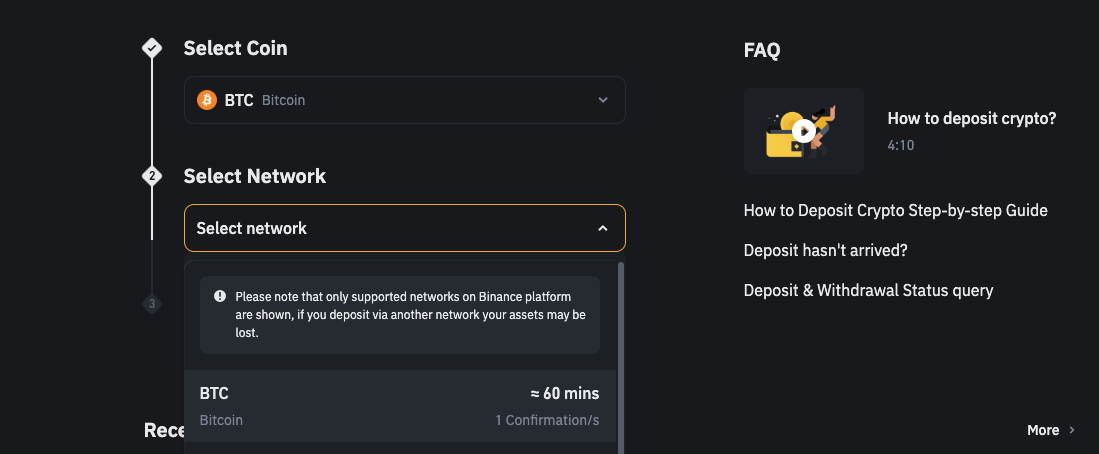
Cryptocurrency exchanges provide Bitcoin (and other crypto) wallets and/or addresses to store, send, and receive Bitcoin. They are essential for interacting with the market(s) and products offered in the exchange’s respective ecosystem – such as an exchange’s peer-to-peer (P2P) function.
Your unique asset address (ex. BTC, ETH, etc…) generated on the exchange is your address to send Bitcoin and other cryptocurrencies from outside the exchange, such as from a Bitcoin ATM, desktop wallet, cold storage wallet, or third-party (ex. Your friend). In reality, you don’t actually need to “generate” an address, rather simply navigate to your ‘wallet’, select ‘BTC’ as the crypto asset, and click ‘Deposit’ – you’ll then see your public key/address and QR code.
Popular cryptocurrency exchanges in Hong Kong include:
- Binance
- Huobi
- OKX
I also have several friends who use HashKey for buying Bitcoin, as it allows for fiat bank transfers (for both HKD and USD).
Pale Ale Travel Tip: If you are looking to purchase ETH, make sure to check out my article breaking down how to buy Ethereum in Hong Kong.
KYC & 2FA Required to Buy & Sell on Bitcoin Exchanges in Hong Kong
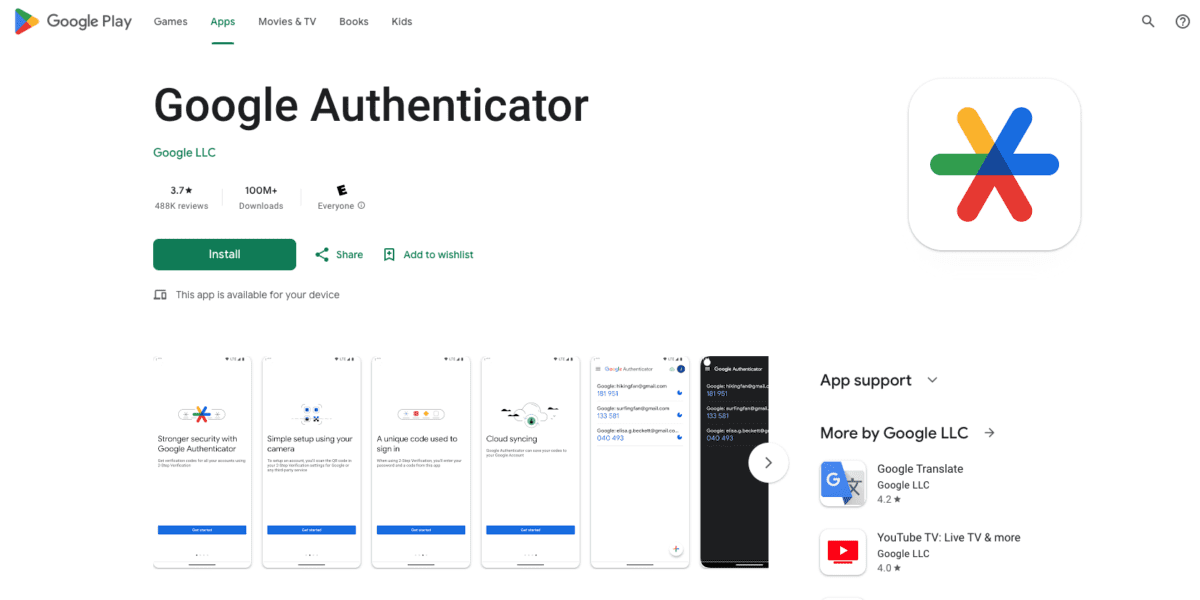
Keep in mind that almost all Bitcoin exchanges will require you to complete KYC (Know Your Customer) and utilize two-factor authentication (2FA) to execute a buy or sell (or withdrawal of an asset from the exchange).
As KYC requires the verification of personal identity documents and other personal information, it is not always instantaneous. Approval times can range from the same day to upwards of a week or more. This is important to keep in mind if you’re in a hurry to buy Bitcoin.
I use ‘Google Authenticator’ as the two-factor authentication app on my phone and always make sure to back up and/or write down the app’s ‘recovery codes’ on a piece of paper – should anything happen to my phone. ‘Authy’ is also another popular two-factor authentication app on the market.
Pale Ale Travel Tip: If you plan on storing your Bitcoin for the long term, I recommend using a hardware wallet or software wallet (which I strongly urge you to do). If you want to ensure that your assets aren’t ever compromised, consider a hardware wallet like Trezor or Ledger (addressed below), or if you use a dedicated computer for crypto, a software wallet may be more than sufficient.
If you already have a Bitcoin wallet (mobile, software, or hardware), simply use your unique Bitcoin address (or QR code) to have your Bitcoin sent to you (unless you’re using a cryptocurrency exchange – then you’ll have your Bitcoin deposited to your unique crypto exchange wallet).
4 Ways to Buy Bitcoin in Hong Kong

As you can tell, I’m a professional graphic designer based on how I placed the Bitcoin logo on a picture of mine.
While Hong Kong’s crypto landscape is still somewhat in its infancy and has existed somewhat in limbo when it comes to regulation and government approval, there are still more than a handful of ways to buy bitcoin in Hong Kong – it just ultimately comes down to what you prioritize that will shape your purchasing method.
For example, if you value convenience and anonymity, then I would recommend using a Bitcoin ATM to purchase your BTC. Or, if you want to avoid costly fees and utilize FPS or your Hong Kong bank account, then I recommend using a peer-to-peer (P2P) function on a cryptocurrency exchange. If you have a robust network of friends who are looking to offload some of their BTC, then I’d simply just recommend meeting them in person and/or transacting with them.
Let’s talk about these key ways you can buy Bitcoin in Hong Kong and the advantages and disadvantages of each.
Pale Ale Travel Tip: As someone who travels semi-frequently and may face issues with various debit cards or credit cards being temporarily locked and/or unusable, I always ensure that I top up a prepaid crypto debit card before or move several hundred USD worth of crypto to a MetaMask wallet. Keep in mind that MetaMask does not support BTC. If I’m ever in a bind, there’s usually some way that I can “spend” or “offload” the crypto for fiat (USD, EUR, etc…). I consider it a hedge and it provides me at least some sort of peace of mind when exploring a new country or city.
Buy Bitcoin Via Cryptocurrency Exchanges
Using a cryptocurrency exchange is my go-to on-boarding and off-boarding ramp to buy and sell Bitcoin in Hong Kong. There are several key ways to buy Bitcoin in Hong Kong via a cryptocurrency exchange such as Binance, OKX, or Huobi. These include:
- Peer-to-Peer (P2P) trades, and
- Bank transfers.
All three of the above crypto exchanges boast P2P functions that directly connect crypto buyers and sellers. I’ve used all three exchanges in some capacity, however, I’ve only used the P2P function on Binance. It’s the only Bitcoin exchange available in Hong Kong that I can vouch for the efficacy of P2P trades. It is also the largest cryptocurrency exchange in the world so there’s never a shortage of P2P buyers and sellers to trade with (and they boast competitive exchange rates).
They also allow the purchase of Bitcoin and crypto via bank transfer. However, at the date of publication, bank transfers may not be available for Hong Kong Dollar deposits on some exchanges (like Binance) – so I will only focus on how you can purchase Bitcoin via P2P transfers.
After all, the goal of this article is to make things as straightforward as possible.
Note: Euros, pounds sterling, and other international currencies are supported.
Below, I’ll briefly explain how I typically buy Bitcoin on Binance – which is through their P2P function.
How to Buy Bitcoin on Binance
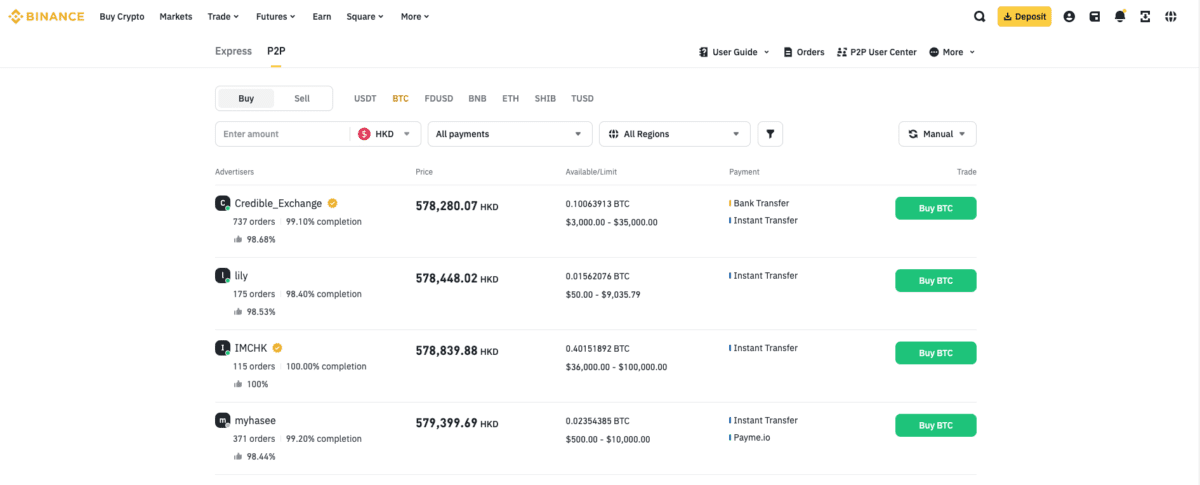
A list of Bitcoin sellers and their rates on the Binance P2P portal.
Buying Bitcoin in Hong Kong via a P2P portal is by far the most straightforward payment method when it comes to quick and painless trades. Using Binance’s P2P portal, buyers and sellers are connected via the platform at an established rate (set by the seller) and several verification checks are in place to ensure a fair and honest trade (such as the platform freezing the asset in a virtual escrow until both parties sign off).
If I want to use my hard-earned Hong Kong Dollars to buy Bitcoin in Hong Kong, I’ll commonly go through Binance’s P2P cryptocurrency trading mechanism. Here’s what it looks like:
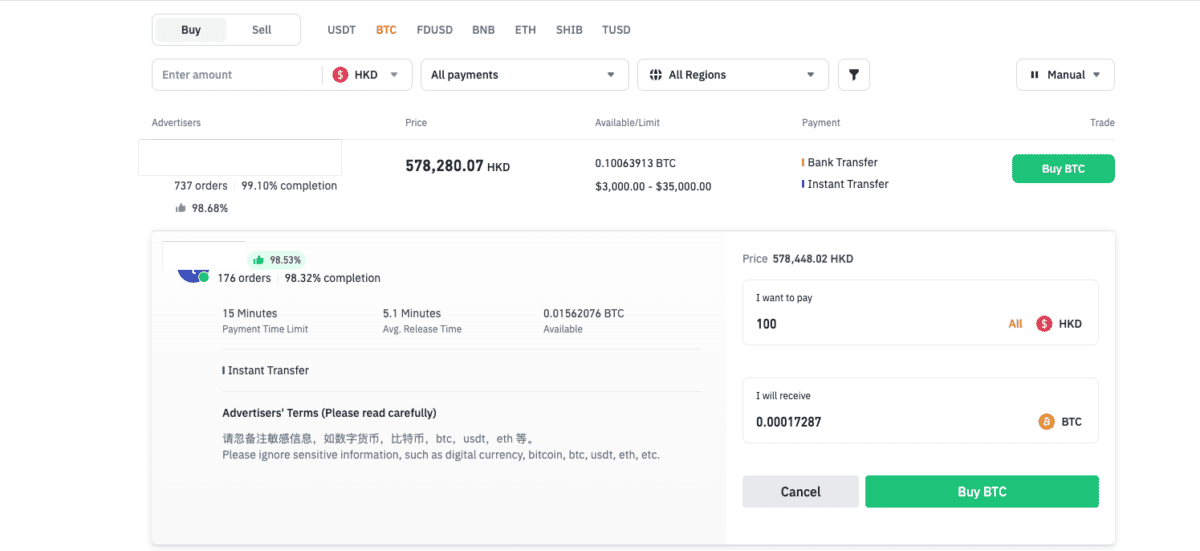
Enter the amount you ‘want to pay’ and click ‘Buy BTC’ to initiate the trade.
First, ensure that you have KYC’ed on Binance and have your authenticator app set up and connected to the platform. The first time I ever used Binance’s P2P system, I didn’t have my authenticator app and let the transaction expire.
- Click ‘Trade’ and then select ‘P2P’,
- Make sure you’ve selected ‘Buy’, ‘BTC’, and ‘HKD’.
- Select the green button that says ‘Buy BTC’
- Select the ‘Transfer Method’ (Instant Transfer or Bank Transfer),
- Enter the amount of HKD you want to spend (you’ll see the corresponding amount you’ll receive in BTC),
- Select ‘Buy BTC’.
After selecting ‘Buy BTC’ you will then have a set amount of time to transfer your HKD to their respective account. Remember, you will almost certainly need to use your authenticator app to approve the transaction so don’t forget to have it downloaded before your trade.
When choosing a BTC seller, make sure to look at the available amount/limit of BTC that they have available to sell along with their accepted payment methods. As I primarily use FPS and bank transfers, I always double-check to make sure they use ‘Instant Transfer’ or ‘Bank Transfer’.
I also recommend checking out the available rates to ensure that you choose a competitive rate. Hint: the further down the pages you click, the less competitive the rate – however, oftentimes the most competitive rates are primarily for large volume trades.
Note: If you run into any issues finding the seller’s bank account, you may be able to ask for their FPS ID. Just make sure you provide confirmation of the transfer in the chat (via screenshot).
Pale Ale Travel Tip: Look at a buyer or seller’s completion rate and number of completed orders. I always try to ensure that the buyer and/or seller I’m using has a 98% or above completion rate and at least several hundred orders/transactions. This is just a personal safeguard I employ but it really depends on you.
Why I Don’t Recommend Using a Credit Card
In my opinion (in Hong Kong at least ), there are too many issues with purchasing Bitcoin with a credit card, as major banks like HSBC often decline transactions. Additionally, you may find yourself running into exorbitant transaction fees that leave you feeling slightly ripped off and questioning where the rest of the crypto you purchased actually went.
For example, Binance’s website has Hong Kong listed as one of the countries that is “temporarily suspended” when it comes to paying with your bank card (for both Visa and Mastercard). Considering this ‘temporary suspension’ occurred in 2020 and here we are four years later with it still in place, I’d say this is not actually that ‘temporary’ and I’d write this payment method off in general.
Hence, this is why I recommend utilizing a crypto exchange’s P2P function. As mentioned above, I use Binance’s P2P function to buy Bitcoin in Hong Kong. Here’s what it looks like (with accompanying screenshots):
OTC Exchanges
An acronym for ‘Over the Counter’ (OTC), OTC exchanges are private trading desks and matchmakers that lay the framework to connect two parties looking to buy and sell Bitcoin (or other cryptocurrencies). Simply put, OTC exchanges allow users to privately contract and transact with one another outside of regulated exchanges – skirting avoiding or publicizing it to the market. The trade is typically executed via wire transfer.
These are highly customizable arrangements that are not backed by an order book (like standard cryptocurrency exchanges) and are generally considered less formal. This means that prices on assets can be negotiated and may result in more favorable exchange rates for larger volume transactions. Anytime you’re dealing in the private market, you do run the risk of counterparty default. However, this may be mitigated through escrow or the use of trusted third parties.
However, if you’re like me (a small peanut) in the Bitcoin and crypto game, OTC exchanges may not be for you, as they are generally geared towards transactions for large investors (not physically large like Kingpin), institutional investors, or other traders or institutions that require customized transaction arrangements. Further, there are typically volume requirements to even get in the door and be able to trade with an OTC desk – with some desks requiring a 10 to 20 Bitcoin minimum – this seems to be the major baseline that most OTC desks quote.
There are however smaller OTC desks in Hong Kong that have lower minimum thresholds, ranging from HK$1,000 to HK$10,000 or more. Exchanges like Binance also have OTC trading desks and functions. To execute a manual OTC trade on Binance, they require a minimum volume of USD 200,000.
Several of the most popular OTC desks in Hong Kong include:
- OSL – for institutional clients and professional investors only (as I said, there’s a good chance this doesn’t apply to you at all)
- BTC Shop HK – a TST OTC desk that has no minimum transaction volume. If the transaction is less than HK$5,000, then they will charge a small handling fee of HK$100.
- Crypto HK – one of the largest OTC counters in Hong Kong with locations in both Admiralty and Tsuen Wan. There’s also no minimum transaction volume.
- OneSatoshi – fiat-to-crypto spot trading with over 10 physical branches in Hong Kong.
- Crypto OTC Digi Castle – Admiralty-located OTC counter with HK$3,000 as a minimum transaction amount.
As of 2024, Hong Kong is in somewhat of a limbo when it comes to regulating OTC desks, due to several fraudulent schemes that rocked the crypto world, with the government eyeing releasing a proposal on the regulated framework of OTC crypto desks and crypto trading in the city.
My recommendation, if you are looking to buy a considerable amount of Bitcoin, opt for cryptocurrency exchange OTC trading desks such as Kraken or Binance if available.
Bitcoin ATMs
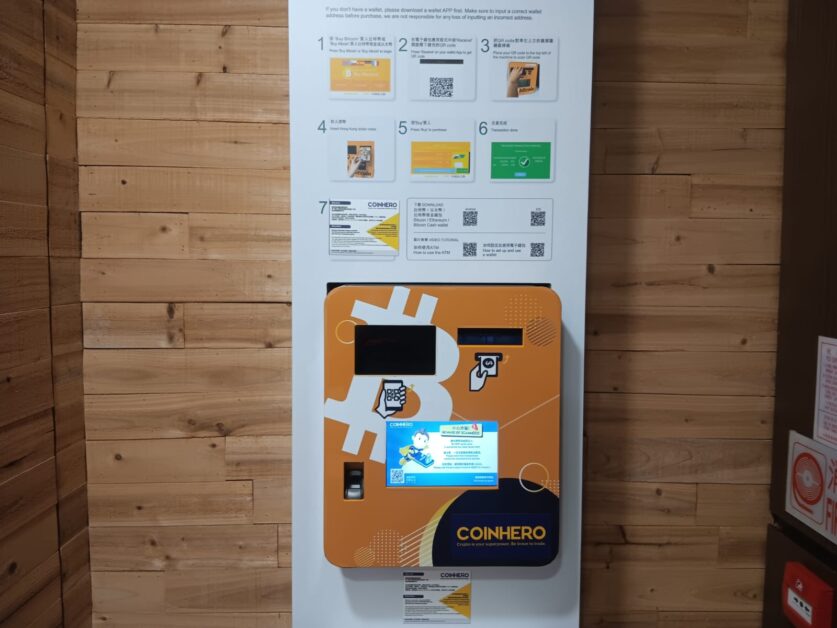
COINHERO Bitcoin ATM at The Hive in Sheung Wan.
A Bitcoin ATM is a kiosk that is very similar (looking) to a traditional ATM that is connected to the internet and enables customers to buy or sell Bitcoin, or other cryptocurrencies (such as Ethereum, Bitcoin Cash, Dogecoin, and Tether), by depositing fiat currency (in this case, it would be HKD).
The funny thing is that there’s actually a Bitcoin ATM at the entrance of the coworking space I work out of (The Hive in Sheung Wan) and I went nearly two years not even realizing it was there until my coworking amigo asked me that fateful question.
What I would emphasize is that using a Bitcoin ATM is going to be one of the most convenient ways to purchase Bitcoin. It’s also an optimal way to purchase Bitcoin in Hong Kong if you are intent on doing so anonymously and/or not leaving a record (I know this sounds sinister but some people just don’t want to have to KYC with a cryptocurrency exchange).
The downside? It is going to be the most costly when it comes to paying transaction fees or markup of Bitcoin’s market price. Fees may range anywhere from 7% of the total transaction price up to 30%. Yikes. Seriously, make sure to do your research before heading to a Bitcoin ATM so that you aren’t on the receiving end of a 30% scam (I’ve provided some reliable websites to locate Bitcoin ATMs below).
Purchasing Bitcoin via a Bitcoin ATM can be done in under 1 minute. What’s great about Bitcoin ATMs is that they will typically outline the steps to buy or sell crypto at the top of the ATM.
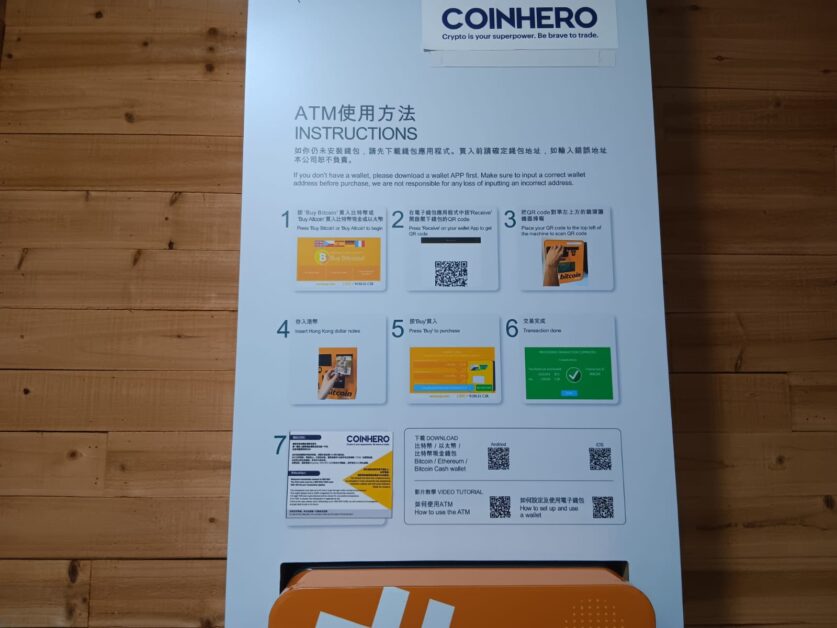
For example, the Bitcoin ATM at my coworking space lays out the six steps needed, which will prompt you to press ‘Receive’ on your Bitcoin wallet (presumably on your phone) to generate your wallet’s QR code, hold the QR code up facing the machine so that it can scan it, insert HKD into the machine, and select ‘Buy’. It’s as simple as that.
There are more than 100 Bitcoin ATMs in Hong Kong, so there’s no doubt that you’ll be able to find one near you. To locate a Bitcoin ATM near you in Hong Kong, I recommend checking out Coin ATM Radar – a site (and giant map) providing global locations of major Bitcoin ATMs. I also recommend using the site ‘HK Bitcoin ATM’.
Several Bitcoin ATMs that I’ve used in Hong Kong include:
- COINHERO Bitcoin ATM in Sheung Wan (at The Hive Coworking Space);
- HK Bitcoin ATM Mongkok Shop;
- COINHERO Flagship Store in Causeway Bay.
Most Bitcoin ATMs in Hong Kong are 24/7 so don’t worry about needing to rush there like the DMV.
Pale Ale Travel Note: My only note about the websites provided is that both may not always be up to date with locations, so I would always consider double-checking to see if the ATM is listed on Google My Business. I usually cross reference to see if there are any recent reviews. Or, if the ATM is close enough (which there is always one a stone’s throw away), I’ll just trek it over and have a look for myself.
Cash in Hand & Offline P2P Transactions
Now this may sound like a crazy one but it was my preferred payment method for several years when the platform LocalBitcoins still existed. In essence, the platform would connect buyers and sellers of Bitcoin, who would set their own rates and methods for trading crypto. One of the main features helped facilitate the connection between Bitcoin buyers and sellers in the same area, who would then meet and exchange crypto and fiat in person.
It was the original Bitcoin ATM before ATMs became more popular – offline peer-to-peer (P2P) transactions with zero third-party interference or regulation (extremely anonymous). However, just because LocalBitcoins is no more doesn’t mean that offline P2P transactions are off the table. It’s still one of the primary ways that I buy and sell Bitcoin – even in Hong Kong. It also boasts the lowest transaction fees (or none at all) due to you being able to set and/or negotiate rates with whoever you are trading with.
However, I wouldn’t recommend this method for those without a network of people they can trust who own Bitcoin and are willing to transact. If I was a betting man though, I am guessing that you have at least one or two friends who may hold some Bitcoin and could be a good starting point if you are unable to use a Bitcoin ATM, exchange, or OTC desk.
If you do decide to meet someone (even if it’s a trusted friend), the reality is that a fair trade looks like you handing over the fiat (cash) first – as if they were to blindly take your word that you have cash on hand, they might ultimately get scammed after transferring Bitcoin to you (if you’re a scumbag). Think of it similar to a Facebook Marketplace transaction for a used bike or set of furniture. Also, cash is a bit easier to report to the police (and trace) if it’s stolen. As the Wu-Tang Clan said, “Cash rules everything around me.”
Pale Ale Travel Note: I gambled heavily for several years and was actually banned from MoneyGram and WesternUnion for receiving random (suspected unlawful) transfers from the Dominican Republic and Curacao. I was also unable to cash the bizarrely large Canadian checks that the offshore casinos would issue me. This left me with no other option but to meet individuals offline and developed into a surprisingly healthy and robust network of friends and traders that I still transact with to this day. It’s also a backup if I am ever in a new country or city and need cash in case of an emergency.
How to Securely Store Your Bitcoin
Now that you’ve purchased your Bitcoin, it’s important to know how to secure it. Avoid storing your newly acquired Bitcoin on an exchange which uses what is called a ‘hot wallet’ (as it is “kissed” by an internet connection). There’s just too much that can go wrong and it’s important to only hold small amounts of crypto on platforms or wallets that you don’t control the ‘private keys’ for.
“Not your keys, not your crypto.”
In an industry rife with scams, grifters, and malicious actors, there’s only one solution I have for storing your Bitcoin safely – a hardware wallet. Think of a hardware wallet as your own personal bank vault.
It’s an actual physical device that acts as your ‘user interface’ to the blockchain. It is commonly referred to as “cold storage” as it is a device that does not connect to the internet (or expose your private keys) and is only accessible with the physical device and passcode and/or seed in your hand.
Simply put, this is as safe as it gets when it comes to securing your Bitcoin and crypto.
The two Bitcoin hardware wallets that I use and recommend include:
- Trezor: My preferred of all Bitcoin hardware wallets due to the simplicity of setting it up and cryptocurrency token support. I primarily use Trezor just for Bitcoin and Ethereum storage.
- Ledger: One of the most popular Bitcoin hardware wallets on the market that looks like a USB stick. It provides support for over 5,500 cryptos, tokens, and applications, and is the primary hardware wallet I use to securely store any altcoins I own.
Pale Ale Travel Note: The only note I’d make about Ledger is that as a company, they did have a data breach (which does not actually affect your crypto in any way, shape, or form) which leaked personal information and emails for countless Ledger users, so I now receive more spam emails than I can shake a stick at.
Always make sure you purchase these from the actual retailer’s website rather than on Amazon or a third-party platform, as it is not unheard of for third-party resellers to tamper with resold hardware wallets.
Also, don’t worry, if you lose your device, you aren’t out of luck and you can still access your funds with the recovery seed which is generated when you first boot up your device.
Finally, I know this all sounds like a lot of technical Bitcoin jargon, and the purpose of this post was to explain how to buy Bitcoin in Hong Kong so don’t stress too much. Acquiring Bitcoin is the name of the game. From there, you’ll be able to find plenty of resources about securely storing it. Consider the above information, just a little primer – to point you in the direction of gaining ‘self-custody’ over your Bitcoin and its storage.
Pale Ale Travel Note: If you have any questions about cold storage and hardware wallets, don’t hesitate to reach out to me. I’ve helped more than a handful of friends understand a bit more about hardware wallets by making short tutorials for them on what to expect when booting it up and getting started.
Buying Bitcoin in Hong Kong Shouldn’t Be Such a Pain
I know it can seem like a royal pain in the rear end to buy Bitcoin in Hong Kong. I agree. This is definitely one of the barriers to entry that still has a ways to go before I imagine we see an even wider scale adoption by retail investors (although, we are trending in a more positive direction than even just several years ago).
But there are options. It is just going to take a slightly little bit more elbow grease than you’d like or may have anticipated but once you’ve set up your respective wallet, KYC’ed (if going through an exchange), and gotten your first successful transaction out of the way, it will be much easier.
If you are looking for the most straightforward and immediate option to buy Bitcoin in Hong Kong, I’d strongly recommend using a Bitcoin ATM or signing up for a cryptocurrency exchange like Binance and utilizing their P2P function.
I could go on various rants about why I think Bitcoin is here to stay and why it’s actually my largest held asset but that may be for another time and another article. If you enjoyed this style post and would like to see more of these, I’d love to hear from you.
Finally, if you have any questions about buying Bitcoin in Hong Kong (or selling), or getting started with cold storage (hardware wallets), please feel free to reach out to me in the comments or by email (info@palealetravel.com).
HODL well everyone,
Big Body
Big Body is a voracious lov…eater, a cowardly fighter, and a self-proclaimed curry goat BBQ-eating champion (don’t forget the donkey milk) who likes Stoicism, baseball, and writing in the third person. Having worked for himself for the last 7 years, he isn’t particularly successful but he does still drink ice-cold Sapporo draft beers with the best of them and knows his way around a Dai Pai Dong or two. He is based in Hong Kong but you can still find him in Saigon, Osaka, and Vienna for extended periods.

Hi, I have a question regarding new crypto regulation in Hong Kong. As of 30th April, we cant purchase any smaller cap alt coins in the licensed exchanges in Hong Kong. Though Binance is still allowing transactions, they may stop their service completely after May. I hold some altcoins and I store them in cold wallets. Do you think its good idea to keep storing them in the cold wallet or sell them in Binance while I still can and just work around with the small selection of altcoin in exchanges like Bybit and OKX? Thank you so much.
Hey there Stash,
Thank you for reaching out and that’s a great question. If I’m understanding correctly, your biggest worry is being unable to sell the altcoins at a later date on Binance? Honestly, I would recommend keeping your altcoins off of any exchange for now and continue with cold storage. From my understanding, you still should be able to transfer BTC, ETH, USDT, and a few others to Binance without worry. If that’s the case, you can then ‘cash out’/swap the altcoins on a popular decentralized exchange for ETH, WrappedBTC, or USDT/USDC and then transfer to Binance. Worst case scenario I’d say is going to an OTC desk in Hong Kong and negotiating with them as they provide fair rates and can also handle large volumes (and also are operating somewhat distanced from traditional exchanges in the regulatory landscape – however, this may be set to change). Best and please don’t hesitate if any other questions (I emailed this as well. -Big Body